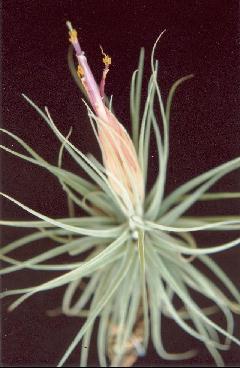
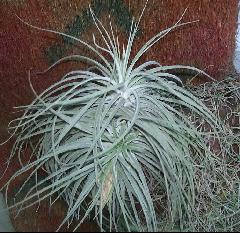
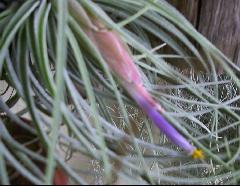
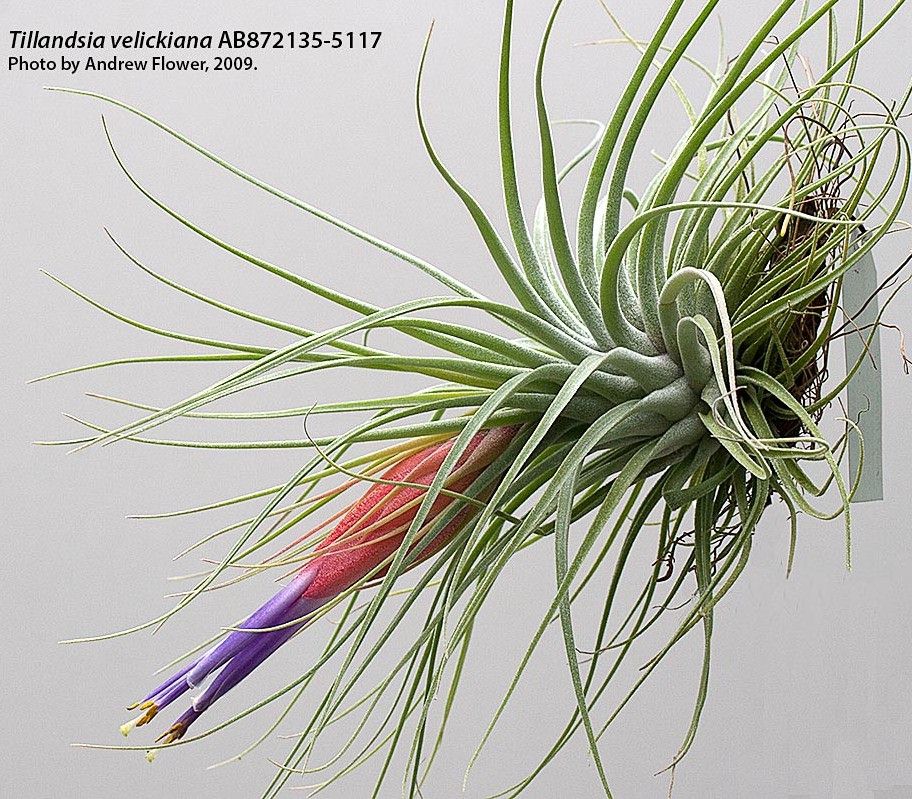
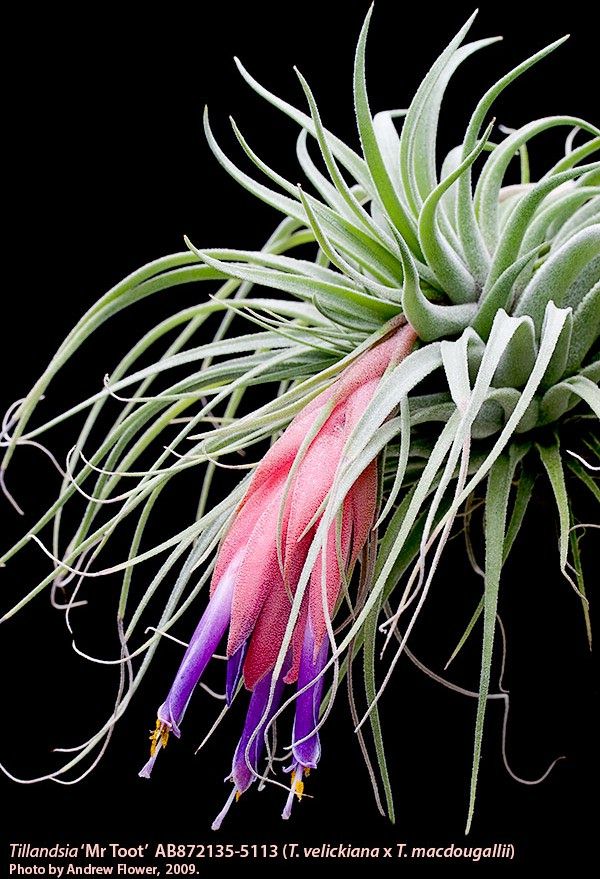
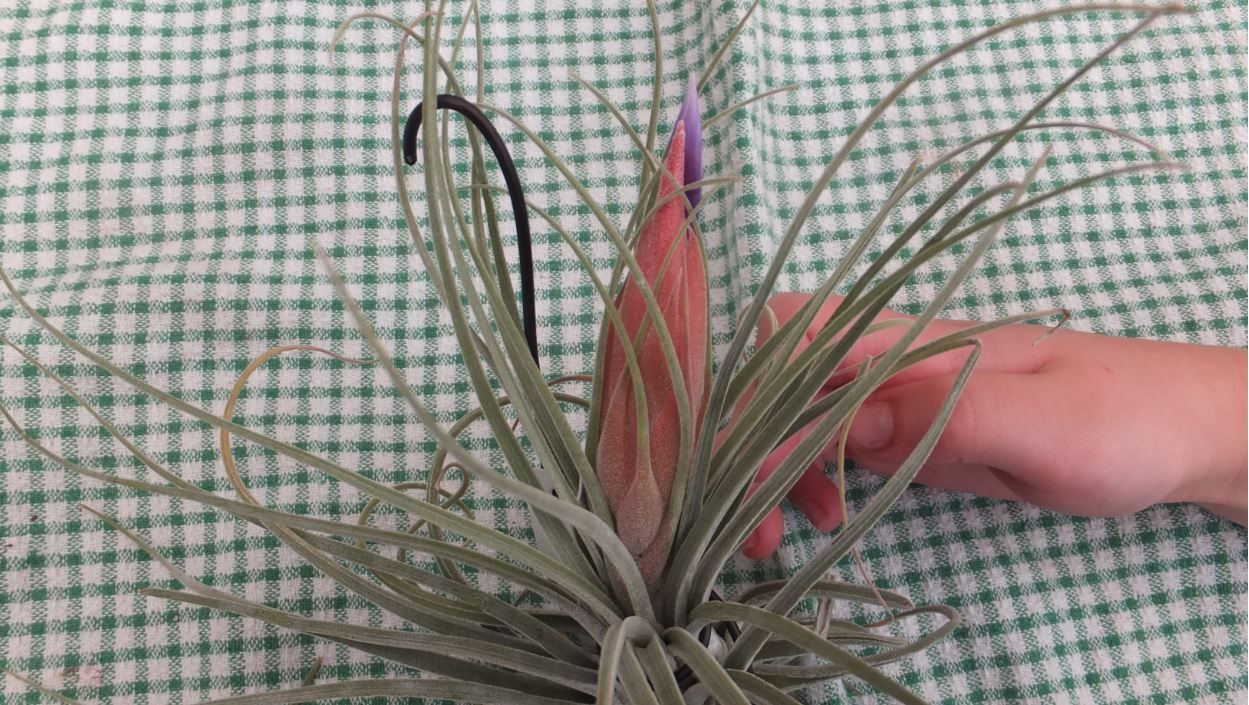
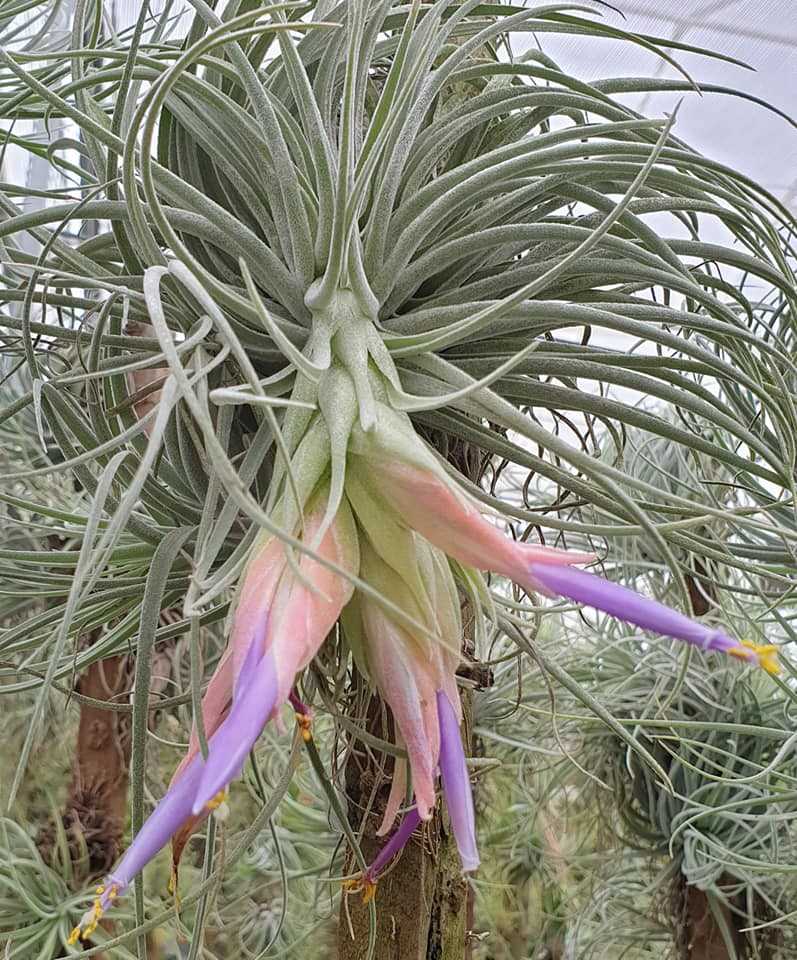
Alfonso Trudu 09/20 ... "A friend of mine on Facebook asked me whether we have T. oaxacana seeds in Australia. They are looking for them in New Zealand. I answered that, although T. velickiana and T. oaxacana are both registered taxa, here we have T. velickiana only. I have never seen T. oaxacana at any meeting or show. He replied that in Europe they can call the plant T. oaxacana because it is called this way in Guatemala where the imports into Europe come from. If this is so, why do we need two names for the same taxon of Tillandsia?"
Peter Tristram ... "The 2 taxon are quite different.
You probably won’t see oaxacana here because it’s difficult in our climate so rarely survived past blooming in the good old days of importing. It does well in NZ and Europe though, and In Coastal California. I brought it back from Juergen Lautner for Chris so maybe there are still survivors here. Same with others from altitude, like macdougallii, erubescens and so on."
Chris Larson ... "The Guatemalan plant trade has always sold T. velickiana as T. oaxacana. It started doing this before T. velickiana was even described.
Many plants in Australian collections have T. oaxacana on tags when they are actually T. velickiana. You can see this on the internet as well. Guatemalan plant traders are still using this name, so some people buying throughout Europe & the US are still purchasing plants under this name. Most of this group are difficult to grow. I killed oaxacana - it just made it through quarantine - but never picked up. T. macdougallii, oaxacana, etc. Not much of them around."
Tillandsia feldhoffii R. EHLERS Die Bromelie pp. 40–41 2/1990
Note that T. feldhoffii was treated as a synonym of T. velickiana by H. Luther in JBS p59 1993. Smith had confused his plant with T. matudae saying that petals were white plus other things!
Plant stemless, flowering to 12cm high, often growing in multiheaded clusters.
Leaves numerous, longer than the inflorescence, arranged in a dense, erect to spreading rosette, to 14cm long, light green, densely covered with spreading grey scales.
Sheaths elliptic, distinct, somewhat arched, 1-2cm long, to 1.2cm wide, light brown, adaxially finer, abaxially coarser, densely grey coloured, spreading lepidote, margins with small asymmetrical trichomes.
Blades 8mm wide above sheaths, narrow-triangular, long filiform-attenuate, strongly involute, subulate, margins strongly curved particularly in basal region.
Scape 1-4cm long, pendent, partly concealed by leaves.
Scape Bracts subfoliate, densely imbricate along scape, many times longer than internodes, with long filiform blades, densely grey lepidote.
Inflorescence pendent, mostly simple (only in few cases with 1-2 smallish lateral spikes), 5-9 cm long, diameter 1.5–3cm, elliptic or fusiform, consisting of 3-7 reduced to one flower containing spikes, which are arranged in densely polystichous fashion (rhachis not visible) around axis.
Primary bracts of the basal flowers resemble the flower bracts, but are lcm shorter than those;
Flowers sessile, erect.
Floral Bracts 3.5-5cm long, 1-1.5cm wide, narrowly oval, acute, exceeding sepals considerably, hyaline, strongly nerved, ecarinate, rosecoloured, with dense fine pruinose scales.
Sepals to 3.3cm long, 8mm wide, narrow elliptic, acute, very thin, glabrous, nerved, free, the posterior ones strongly carinate.
Petals forming an erect tube, to 7.5cm long, 8mm wide at the apex, 4mm wide at the base, lingulate, acute, the apices only slightly recurved, upper half violet, white towards base.
Stamens and Pistil far exceeding petals (style to 1.8cm, filaments to lcm)
Filaments to 7.8cm long, arranged in two rows of unequal length, at apex 1mm in oval cross-section, violet, becoming white and tapering towards base.
Anthers attached 1/4 from base, 3mm long, elliptic, brownish,
Pollen rich yellow. Style 1.8cm long, white, Stigma yellowish, 2mm high, 3mm wide, slightly twisted, lobes somewhat spreading and papillose.
Ovary 6mm long, 2mm wide, conical, light green.
Holotype: Guatemala, Depto. Quiche, caniya, 1500- 2400 m, epiphytic, leg. Uwe Feldhoff, WU (herbarium of the University of Vienna).
Distribution: Guatemala, Depart. Quiche. Besides at locality of type collection, the plant was also collected at Zacapula (Depart. Quiche) at 2000 m: Werner Welz, Hamburg, No.2275, 1989; Rauh 44034, Depart. Quiche, Uspantan, 1800 m on pines, and Rauh 44067, 27.8.77, Depart. Quiche, Huehuetenango. The plant was collected in Guatemala by Prof. Werner Rauh already in 1975 and 1977, but was then classified as T. velickiana L.B. SMITH. In November 1989 he acknowledged it as a distinct species while on a journey to Guatemala.
From article by Harry Luther in JBS 1993 p59
One of the most confusing and frequently misidentified species of cultivated Tillandsia is T. velickiana L.B. Smith. Opinions regarding its identity and status have varied widely and changed rapidly. My own "Explanations For Taxa No Longer on the Bromeliad Binomial List", BIC, 1 May 1992 (distributed to BSI affiliated societies), was caught in midstride, so to speak, with T. velickiana listed both as a synonym and as a valid name.
In the spring of 1992, I examined and compared types of T. velickiana and T. matudae L.B. Smith, supplemental material in herbaria and in cultivation, the original literature pertaining to those species
Smith, 1949, 1974a, 1974b ), and the published account of the recently described species T. feldhoffii Ehlers (1990). It is now reasonably certain what taxa exist, how they should be circumscribed, and how most of the confusion developed. The following should clear up most of the misunderstandings.
In his original description of T. velickiana, L.B. Smith (1974a) compared Gerson Velick's new species to both T. lepidosepala L.B. Smith and T. benthamiana Klotzsch ex Baker (now T. erubescens Schlectendal). T. velickiana actually shares very few characters with the former but appears to be closely related to the latter differing, as stated in the Latin diagnosis, by a shorter scape, and scape bracts much shorter than the floral bracts. So far, so good!
Problems begin with the full English description. At this point, it must be explained that the sender, Velick, was not aware that his shipment of unknown Guatemalan tillandsias evidently contained two superficially similar species: the new T. velickiana and the earlier-described T. matudae. The stated petal color (white) was not observed by either Smith or Velick but was based on a description of another plant from the original shipment (undoubtedly a T. matudae) flowered by William Paylen (correspondence in the T. velickiana folder at the United States National Herbarium (US). In addition, a supplementary note (with the species name misspelled) in the Journal of the Bromeliad Society (Smith, 1974b) was illustrated with an excellent photograph taken by Kathy Dorr (G. Velick, pers. comm., 1992) of a well-grown T. matudae. I am certain that this photo along with the somewhat fragmentary and distorted state of the type specimen (one of the inflorescences is flattened and appears to be more or less distichously-flowered) was the main cause for C.S. Gardner's decision to sink T. velickiana into T. matudae (Gardner, 1983, 1986). Most of us followed her lead.
The epithet velickiana may have disappeared from use but the plants continued to be exported from Guatemala. Commercial horticulture abhors a nomenclatural vacuum so the "unnamed" tillandsia was soon dubbed Tillandsia "oaxacana Guatemala".
Tillandsia oaxacana L.B. Smith is another closely related species but is amply distinct morphologically and does not grow very near to Guatemala. Renate Ehlers (1990) recognized that the Guatemalan plant was not T. oaxacana (and it could not be the T. velickiana if that plant were the same as T. matudae); therefore, it needed a name which she supplied: T. feldhoffii. She described and illustrated it accurately and fully. There is no confusion associated with the name. However, I consider it to be a superfluous renaming of the older T. velickiana.
Up to this point, I have described events that, in a perfect world, should not have occurred:
a) the mixing of characters of two distinct species in an original description,
b) the use of a misnamed photo of a different species in a supplemental note,
c) the erroneous synonymizing of a good species and its renaming.
Can Tillandsia velickiana really be distinguished from T. matudae? Can it be separated from T. feldhoffii?
We need to look at the type specimens (the original dried specimens on which the species author based their names). Note that T. velickiana has a simple, elliptical inflorescence with more or less polystichously-arranged, densely lepidote floral bracts. No mature flowers are preserved on the type but nearly all observers report blue or blue-violet tubular corollas with conspicuously exserted stamens and style. I concur with the latter observation.
In contrast, T. matudae has a compound, digitate inflorescence with distichously arranged, sparsely lepidote (often nearly glabrous) floral bracts. The flowers of the type appear to have included stamens and style. No color is stated. They are now known to have exserted stamens and style and white petals. This is clearly shown in the photo of "Tillandsia velickeana" (sic) mentioned above. So, T. velickiana can be distinguished from T. matudae by flower arrangement (polystichous, not distichous), by floral bract indumentum (densely, not sparsely lepidote) and by corolla color (blue or blue-violet, not white).
Accordingly, T. velickiana and T. matudae are clearly good, distinct species.
It must be mentioned that both Drs. W. Rauh and J. Rutschmann understood the problems back in 1975 (correspondence in specimen folders at US) but did not elaborate or clarify matters in the literature. The reason may have been the existence of specimens (cf. Rauh 38838, 38842, 44063 at US) with characters intermediate between T. velickiana and T. matudae (compound inflorescences and partially or wholly distichously-arranged, lepidote floral bracts). In my opinion, these odd plants could represent hybrids as both Rauh and Rutschmann reported that T. velickiana and T. matudae were sympatric at several sites in Guatemala (correspondence in specimen folders at US).
I have not examined the holotype specimen to T. feldhoffii, but my evaluation of the habit photograph, the drawing of the floral details, and the full description in its original publication (Ehlers, 1990), gives me confidence that it does not differ significantly from the type of T. velickiana. I, therefore, consider T. feldhoffii to be a synonym of the earlier T. velickiana.
In closing, I believe I should warn horticulturists that both T. velickiana and T. matudae may present problems in cultivation. Both are native to moist pine/oak cloud forests of ca. 2000 m elevation. This means that they require cool nights. They are usually impossible to cultivate in hot, lowland areas.
From Feldhoff July 2010.
Dear friends: Yesterday I received the pictures finally, because not before that is. These plants that he sends are typical average for each species. The Tillandsia matudae always the spike this divided in 3 to 5 ramifications, the color is always yellow to rosy pale, and the petals of the flower are always white to white creamy. The Tillandsia feldhoffii the spike is always rosy strong and the spike is inflated and the color of the petals is always blue until dying. The Tillandsia velickiana has a green spike until yellowish and sometimes divided in 2 sprays, the petals of the flower are white until the base and a pale blue below, I believe, to my approach, this is intermedia of the 2 previous plants and until today it never gave seed capsules like the 2 previous. For that reason I believe that it is a hybrid of matudae with feldhoffii or vice versa. The velickiana doesn't cross with feldhoffii or matudae, because they never give seed (to my knowledge).
Without further ado, greetings from Uwe and Hector.
Butchers note. Aug 2010.
As far back as 1975 we know that hybridity was suspected but which are the hybrids and which are considered the species? Remember that albino forms occur fairly frequently in subgenus Tillandsia so we have to be careful with petal colour. Feldhoff does not fully describe feldhoffii sensu Feldhoff but we assume an inflated spike suggest polystichous flowering. Renate has pointed out she was rather hasty in saying petals violet and white towards base because this is the norm to expect once you get underneath the sepals, T. matudae was described as having distichous flowers but T. velickiana did not know quite
what to do – starting as polystichous!. Is this a sign of hybridity? Should we bring T. feldhoffii back to species status and treat T. velickiana as T. x velickiana ? The answer lies with careful botanical collecting in Guatemala but who can we get to do this?